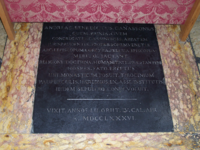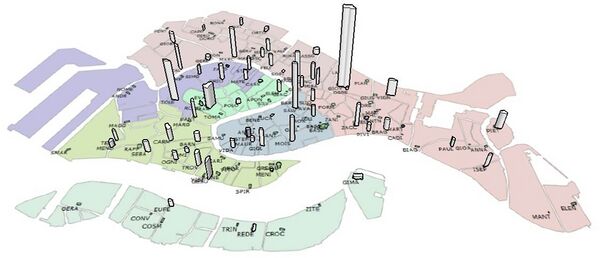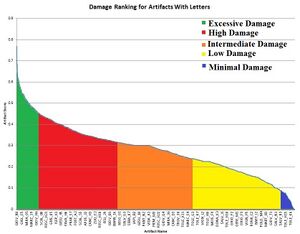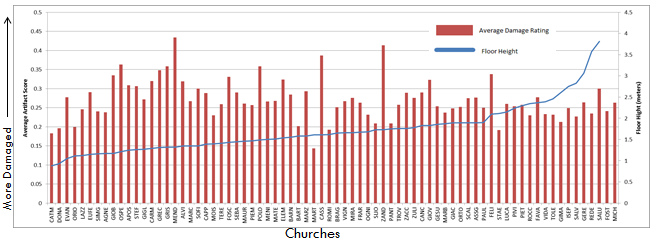Church Floor Artifacts
This article contains information on the Church Floor Artifacts of Venice. For a list of Churches in Venice, see Churches. For information on a typical artifact, see Church Floor Artifact.
 | |
| Churches with Assessed Artifacts | 74 |
|---|---|
| Total Number of Artifacts | 2221 |
| Number of Tombs | 1724 |
| Number of Plaques | 497 |
The artwork in Venetian churches is not limited to sculptures and paintings displayed on the walls. Many artifacts are found below eye level, in the floors. Venetians used every surface available to decorate all aspects of their lives, including the ground they walked on. In the floors of Venetian churches, two types of artifacts can be found: the more common artifacts is a tombstone, marking a Venetian’s final resting place. These markers are from when burials were still allowed inside city centers and usually contain the individual’s full name, date of birth and date of death. Other information, such as the person’s occupation, can be found on some of the more elaborate pieces. Additionally, plaques are inlaid in church floors which contain information about important events, such as the beginning of construction or prominent contributors. Many of the artifacts are carved into tiles, usually marble or limestone, to compliment the surrounding floor pattern in order to distinguish them as a Church Floor Artifact. Different color marbles, such as red, white or black, were used to set the markers apart from the rest of the floor while still keeping a uniform appearance throughout the church.[1]
Churches with Artifacts
The map below shows the churches of Venice, excluding the Lagoon islands, represented as vertical bars, where the height of each church building corresponds to the number of floor artifacts found in the church. For example, the tallest bar on the graph corresponds to the Church of San Zanipolo (Santi Giovanni e Paolo) in Castello which has 207 church floor artifacts. Of the represented churches, the average number of artifacts is 30. At the other extreme, there are two churches, Church of San Luca and Church of Redentore, that only have one artifact each.[2]

Statistical Data

The artifacts were divided into five categories as described on the Church Floor Artifact page. The picture to the right depicts how the five categories are organized. The three middle categories, high damage, intermediate damage and low damage, were determined to be the best candidates for preservation efforts. The two categories on the outside, excessive damage and minimal damage were determined to have either sustained too much damage, or not enough damage, and therefore would not be a productive use of preservation resources.
Condition Evaluation
The graph below shows the number of artifacts per church in each of the three middle categories. The red bars correspond to the high damage category, orange to intermediate damage and yellow to low damage. The taller bars represent churches with a large quantity of damaged artifacts. It is very clear that GIOV, Church of San Zanipolo, has the highest number of artifacts in the high damage category, as well as many artifacts in the intermediate and low damage catagories. Therefore, the floor of this church is a strong candidate for restoration. Additionally, the churches APOS, Church of Santi Apostoli, SALV, Church of San Salvador, SCAL, Church of Gli Scalzi, TOLE, Church of Tolentini, FAVA, Church of La Fava, and MARC, Church of San Marcuola, all have red and yellow columns that are significantly higher than the other churches. These higher bars represent the church floors with many highly damaged artifacts and would benefit from preservation efforts.[3]

In addition to the number of artifacts per church in the high damage category, the percent of artifacts in the high damage category was studied. The results of this are seen in the graph below. This analysis removed some of the bias of the previous figure based on simply the quantity of artifacts in a church, resulting in only the churches with the highest number of total artifacts showing the highest number of highly damaged artifacts. APOS, Church of Santi Apostoli, CAPP, Church of Le Cappuccine, GREC, Church of Greci, LUCA, Church of San Luca, POLO, Church of San Polo, and REDE, Church of Redentore all have a high percentage of the artifacts in their floors in the high damage category. A high percentage of highly damaged artifacts causes these church floors to be considered a high priority for preservation. Bias does exist in this graph as well, since churches such as Church of San Luca and Church of Redentore both have 100% high damage artifacts but only have one artifact.[4]

Looking at both graphs and comparing the results, the Churches that have the highest need for preservation become evident. The Church of Santi Apostoli emerged as a high priority for both the quantity and percentage of high damage artifacts analysis. Therefore, the Church of Santi Apostoliis a strong candidate for preservation efforts.[5]
Church Floor Height
Many churches have been rebuilt or undergone extensive renovations since they were first constructed. A common aspect of renovation was to raise the floor of the church, by either removing the old floor, or building on top of it. It stands to reason that these new floors would contain fewer artifacts, as they have not been in the church for as many years, and therefore would not contain as many artifacts. A weak correlation exists between the elevation of Venetian church floors and the condition of the artifacts in the floor as seen in the graph below. The red bars correspond to the average artifact damage score of each church, while the blue line represents the floor height of that particular church. As the blue line increases across the graph, the damage to the artifacts per church decreases slightly. Further analysis of when these floors were renovated might provide more insight as to a stronger correlation. [6]

Map
There are 74 churches in the city of Venice that have assessed church floor artifacts, six of which are located on the Lagoon islands. Below is a map where one can find the location of the churches with assessed artifacts. The 65 churches that are not shown on this map are either churches that are known to not have artifacts or churches with floors that could not be viewed to determine if artifacts are present in their floors. All of these churches can be found on the Churches page.[7]
<display_map height=600 zoom=14 centre=45.440155,12.345403> 45.432596,12.315829|Church of San Nicolo dei Mendicoli 45.433282,12.316219|Church of Le Teresa 45.431996,12.320083|Church of San Sebastiano 45.4453,12.320104|Church of San Giobbe 45.437806,12.321831|Church of Tolentini 45.441437,12.322011|Church of Gli Scalzi 45.433754,12.322091|Church of Carmini 45.43139,12.323435|Church of Ognisanti 45.426919,12.323616|Church of Sant'Eufemia 45.447246,12.323993|Church of Le Cappuccine 45.440825,12.324395|Church of San Simeon Grando 45.432053,12.324449|Church of Le Romite 45.435999,12.32449|Church of San Pantalon 45.442725,12.325268|Church of San Geremia 45.433209,12.325297|Church of San Barnaba 45.436997,12.325308|Church of San Rocco 45.430902,12.325918|Church of San Trovaso 45.438214,12.326034|Church of San Giovanni Evangelista 45.437114,12.326665|Church of Frari 45.429404,12.327164|Church of Gesuati 45.440306,12.327367|Church of San Giacomo dell'Orio 45.441751,12.327774|Church of San Zandegola 45.429983,12.328113|Church of Sant'Agnese 45.443226,12.328588|Church of San Marcuola 45.448149,12.329014|Church of Sant'Alvise 45.432436,12.329398|Church of S. Vidal 45.43721,12.329532|Church of San Polo 45.440238,12.330371|Church of Maria Mater Domini 45.441525,12.330671|Church of San Stae 45.425518,12.330747|Church of San Trinità 45.43372,12.331042|Church of San Stefano 45.433087,12.33157|Church of San Maurizio 45.439702,12.332063|Church of San Cassian 45.443051,12.33218|Church of Santa Fosca in Cannaregio 45.425212,12.332451|Church of Redentore 45.446591,12.332526|Church of La Madonna dell'Orto 45.43274,12.332753|Church of Santa Maria Zobenigo 45.44388,12.33288|Church of San Marziale 45.441723,12.333379|Church of San Felice 45.435839,12.333649|Church of San Luca 45.430179,12.334035|Church of Catecumeni 45.438711,12.334383|Church of San Giovanni Elemosinario 45.43102,12.334754|Church of La Salute 45.441087,12.335001|Church of Santa Sofia 45.424921,12.33516|Church of La Croce 45.438598,12.33531|Church of San Giacometo di Rialto 45.433134,12.336048|Church of San Moisè 45.437731,12.336229|Church of San Bartolomeo 45.43688,12.336506|Church of San Salvador 45.439155,12.337227|Church of San Giovanni Grisostomo 45.437064,12.338003|Church of La Fava 45.437617,12.33846|Church of San Lio 45.440161,12.338539|Church of San Canciano 45.435956,12.338582|Church of San Zulian 45.439566,12.339194|Church of Miracoli 45.443633,12.339254|Church of Gesuiti 45.43959,12.34153|Church of San Zanipolo 45.4414,12.342468|Church of Mendicanti 45.429642,12.342646|Church of San Giorgio 45.438842,12.342818|Church of L'Ospedalletto 45.434724,12.343557|Church of San Zaccaria 45.435571,12.344636|Church of Greci 45.434311,12.344963|Church of La Pietà 45.43621,12.345968|Church of San Giorgio degli Schiavoni 45.434455,12.346797|Church of La Bragora 45.449286,12.346882|Church of San Michele 45.438457,12.347661|Church of La Vigna 45.434662,12.348949|Church of San Martino 45.45502,12.352626|Church of San Pietro Martire 45.432958,12.354037|Church of San Francesco di Paula 45.430633,12.357167|Church of San Giuseppe 45.457527,12.357232|Church of San Donato 45.434805,12.359779|Church of San Pietro di Castello 45.498368,12.418744|Church of Santa Fosca in Torcello </display_map>
See Also
References
- ↑ Dechaine, Danielle, Hennessey, Meghan, Orszulak, Jeffrey, Rullmann, Kevin. Treasures Underfoot: Preserving Venice's Church Floor Artifacts. An Interactive Qualifying Project for Worcester Polytechnic Institute. 2012.
- ↑ Dechaine, Danielle, Hennessey, Meghan, Orszulak, Jeffrey, Rullmann, Kevin. Treasures Underfoot: Preserving Venice's Church Floor Artifacts. An Interactive Qualifying Project for Worcester Polytechnic Institute. 2012.
- ↑ Dechaine, Danielle, Hennessey, Meghan, Orszulak, Jeffrey, Rullmann, Kevin. Treasures Underfoot: Preserving Venice's Church Floor Artifacts. An Interactive Qualifying Project for Worcester Polytechnic Institute. 2012.
- ↑ Dechaine, Danielle, Hennessey, Meghan, Orszulak, Jeffrey, Rullmann, Kevin. Treasures Underfoot: Preserving Venice's Church Floor Artifacts. An Interactive Qualifying Project for Worcester Polytechnic Institute. 2012.
- ↑ Dechaine, Danielle, Hennessey, Meghan, Orszulak, Jeffrey, Rullmann, Kevin. Treasures Underfoot: Preserving Venice's Church Floor Artifacts. An Interactive Qualifying Project for Worcester Polytechnic Institute. 2012.
- ↑ Dechaine, Danielle, Hennessey, Meghan, Orszulak, Jeffrey, Rullmann, Kevin. Treasures Underfoot: Preserving Venice's Church Floor Artifacts. An Interactive Qualifying Project for Worcester Polytechnic Institute. 2012.
- ↑ Dechaine, Danielle, Hennessey, Meghan, Orszulak, Jeffrey, Rullmann, Kevin. Treasures Underfoot: Preserving Venice's Church Floor Artifacts. An Interactive Qualifying Project for Worcester Polytechnic Institute. 2012.
Bibliography
- Dechaine, Danielle, Hennessey, Meghan, Orszulak, Jeffrey, Rullmann, Kevin. Treasures Underfoot: Preserving Venice's Church Floor Artifacts. An Interactive Qualifying Project for Worcester Polytechnic Institute. 2012.
- Gagnon, Davidm Thompson, Kelly, Ruscitti, Eric. Embedded Heritage: A Study of Venetian Church Floors. An Interactive Qualifying Project for Worcester Polytechnic Institute. 2005.
- S. Hoey, M. Kahan, P Marchetti, K Mazza. Convents, Palaces and Churches: Transformation of Historic Buildings and the Impact on Venice’s Neighborhoods. An Interactive Qualifying Project for Worcester Polytechnic Institute. 2003.
- Santos,Luiz G., Petrowski,Craig Peter, Kristant,Elaine Hazel, Delaive,Amanda Leigh. The Church Floors in Venice, Italy -- an Archeological Study and Analysis. An Interactive Qualifying Project for Worcester Polytechnic Institute. 2002.
External Links
None